Medicine > Solutions Guide > Adult CCRN Exam/ Barron's CCRN Review Book Complete solution guide. (All)
Adult CCRN Exam/ Barron's CCRN Review Book Complete solution guide.
Document Content and Description Below
Barron's CCRN Review Test Prep. Describe normal heart sounds. - S1 - Lub - Caused by closure of AV valves - Loudest at apex of the heart (midclavicular, 5th intercostal space) - Marks end of di... astole, beginning of systole S2 - Dub - Caused by closure of semilunar (aortic, pulmonic) valves - Loudest at the base (right sternal border, 2nd intercostal space) - Marks end of systole, beginning of diastole - Louder with pulmonary embolism Describe the heart auscultatory points on the chest wall and associated valves. - The base of the heart is the aortic area, where S2 is loudest. It is as the 2nd intercostal space, right sternal border. The apex of the heart is the mitral area, where S1 is loudest. Anatomically, it is at the 5th ICS, midclavicular. What are abnormal heart sounds in adults? - S3 S4 pericardial friction rub murmur Describe the S3 heart sound. - - caused by a rapid rush of blood into a dilated ventricle occurs early in diastole, right after S3 - heard best at the apex with the bell of the stethoscope - associated with heart failure; may occur before crackles - ventricular gallop, "Kentucky" Caused by: pulmonary hypertension and cor pulmonale mitral, aortic, or tricuspid insufficiency Describe the S4 heart sound. - - caused by atrial contraction of blood into a noncompliant ventricle - occurs right before S1 - best heart at the apex with the bell of the stethoscope - associated with MI, infarction, HTN, ventricular hypertrophy, and aortic stenosis - atrial gallop, "Tennessee" In atrial fibrillation, what heart sounds cannot be heard? Why? - S4 There is no atrial contraction. What is the formula for pulse pressure? What is a normal value? - SBP - DBP = PP 40-60 mmHg What do SBP and DBP measure? - SBP is an indirect measurement of CO and stroke volume. DBP is an indirect measurement of SVR. What do narrowing or widening pulse pressures indicate? - A decrease in SBP with little change or an increase in diastolic pressure is narrowing of pulse pressure. This is seen most often with severe hypovolemia or a severe drop in CO. (ex. 100/78) A decrease in DBP that widens pulse pressure may indicate vasodilation, a drop in SVR; often seen in sepsis, septic shock (ex. 100/38) Describe the process of heart valves opening and closing. - Normal heart sounds are due to valve closure. Valves open and close based on pressure changes in chambers above and below the valve. When the pressure in the chamber above a valve is higher than that below the, the valve opens. When the pressure drops in the chamber above the valve and the pressure is greater below the valve, the valve closes. Systole: ejection, high pressure Diastole: filling, low pressure Which is longer, systole or diastole? - Diastole Why do CO and BP drop with extreme tachyarrhythmias? - There is no time for filling, therefore less output. What are 9 causes of valvular heart disease? - 1. CAD 2. ischemia 3. acute MI 4. dilated cardiomyopathy 5. degeneration 6. bicuspid aortic valve 7. rheumatic fever 8. infection 9. connective tissue diseases What is the difference between murmurs of insufficiency and murmurs of stenosis? - Murmurs of insufficiency (regurgitation) occur when the valve is closed. Murmurs of stenosis occur when the valve is open. When does mitral insufficiency occur? Mitral stenosis? When does aortic insufficiency occur? Mitral stenosis? - Mitral insufficiency occurs when the mitral valve is closed during systole. Mitral stenosis occurs when the mitral valve is open during diastole. Aortic insufficiency occurs when the aortic valve is closed during systole. Aortic stenosis occurs when the aortic valve is open during diastole. How are murmurs associated with an acute myocardial infarction? - The mitral valve is attached to the left ventricular wall by the papillary muscles and the chordae tendineae. Myocardial ischemia can affect mitral valve function and lead to acute mitral valve regurgitation. What are modifiable risk factors for acute coronary syndrome? - smoking atherogenic diet alcohol intake physical activity dyslipidemias HTN obesity DM metabolic syndrome Compare unstable angina, NSTEMIs, and STEMIs. - Unstable angina - chest pain at least, unpredictable, may be relieved with nitroglycerin, troponin negative, ST depression, T-wave inversion NSTEMI - troponin positive, ST depression, T-wave inversion, unrelenting chest pain STEMI - troponin positive, ST elevation in 2+ continuous leads, unrelenting chest pain Describe variant or Prinzmetal's angina. - - unstable angina associated with transient ST segment elevation - caused by coronary artery spasm - occurs at rest, may be cyclic - may be precipitated by nicotine, ETOH, cocaine - troponin negative - nitroglycerin results in CP relief; STs return to normal How is acute chest pain managed? - - STAT ECG (within 10 minutes) - aspirin (chewed) - anticoagulant - anti-platelet - beta blocker (unless ACS due to cocaine) - treat pain (NTG, morphine) - cardiac biomarkers, lipid profile, CBC, bytes, BUN/Cr, Mg, PT/PTT Describe ECG lead changes in acute coronary syndrome and the locations of coronary artery disease they suggest. - II, III, aVF: right coronary artery, inferior LV V1, V2, V3, V4: left anterior descending artery, anterior LV V5, V6, I, aVL: circumflex, lateral LV V5, V6: low lateral LV I, aVL: high lateral LV V1, V2: RCA, posterior LV V3R, V4R: RCA, RV infarct Describe an inferior myocardial infarction. - - associated with RCA occlusion - ST elevation in II, III, and aVF - associated with AV conduction disturbances - systolic murmur, MVR secondary to papillary muscle rupture - tachycardia Use beta blockers and NTG with caution. Describe a right ventricular infarct. How would you treat it? What should you avoid? - - RCA supplies inferior wall of LV and RV, causing RV infarct - use right-sided ECG Signs/Symptoms - JVD, high CVP, hypotension, clear lungs, bradycardia - ST elevation Treatment - fluids - positive inotropes Avoid - preload reducers (nitrates, diuretics) - caution w/ beta blockers Describe an anterior MI. - - associated with LAD occlusion - ST elevation in V1-V4, V leads - 2nd degree Type II AV block or RBBB - systolic murmur Treatment of STEMI - - determine onset. If symptoms <12 hours, reperfusion - PCI (door-to-balloon in 90 minutes) - fibrinolytic drug therapy (door-to-drug is 30 minutes) How do you care for a patient following a PCI 2/2 STEMI? - - monitor for signs of reocclusion (CP, ST elevation) - vasovagal reaction during sheath removal (fluids, atropine) - hypotension <90 SBP w/ absence of compensatory tachycardia - pallor, N/V, yawning, diaphoresis - bleeding at sheath site (manual pressure 2 fingers above puncture site for 20-30 minutes) - retroperitoneal bleeding (fluids, blood products) - severe lower back pain - pulse assessments How do you care for a patient following a fibrinolytic following STEMI? (contraindications, evidence of reperfusion) - Contraindications - prior cranial hemorrhage - cerebral vascular lesion - intracranial neoplasm - ischemic stroke within 3 months (except within 3 hours) - aortic dissection - active bleeding - closed head or facial trauma Evidence of reperfusion - CP relief (due to fibrinolysis of clot) - resolution of ST segment deviations (due to return of blood flow) - elevated of troponin/CK (due to myocardial stunning when vessel opens) -reperfusion arrhythmia (VT, VF) Nursing Management - assess for bleeding (change in LOC, brain bleed) - assess for reocclusion (returning CP, St deviation) Describe the treatment of an NSTEMI. - - no emergent reperfusion - same meds as STEMI (fibrolytics) - if high risk score or continued CP, instability; start GP IIb/IIIa inhibitors (Integrilin [eptifibatide], Reopro [Abciximab]) and prepare for Cath lab within 24 hours Complications of an acute MI - Arrhythmias - VT or VF - Bradycardia, blocks, SSS - a-fib 10-15% of all MIs have increased mortality even when returned to NSR. Heart failure Cardiogenic shock Reinfarction Thromboembolic events Pericarditis Ventricular aneurysm Ventricular septal defect Papillary muscle rupture Cardiac wall rupture What is the goal of a PCI with a stent? - restoration of blood flow distal to a coronary artery lesion with partial or total occlusion What are complications of PCI? - Stent thrombosis - Most occur acutely (within 24 hrs) or sub acutely (within 30 days) Retroperitoneal bleed Deaths are rare (1.8%) MI (0.4%) Coronary artery perforation Distal coronary artery embolization Intramural hematoma Stroke or TIA Arrhythmias Renal failure After PCI, describe patient care during sheath removal. - - record baseline pulses and VS - analgesic (2-4mg morphine) before removal - Q5-10 BP during removal - monitor for vasovagal response (SBP <90, bradycardia, pallor, nausea, yawning, diaphoresis) -- hold nitrates -- atropine 0.5 mg (even w/o bradycardia in presence of other s/s) -- 250mL NS bolus if atropine ineffective - achieve hemostasis --manual pressure 20-30 min Describe the difference between a hypertensive crisis/emergency and hypertensive urgency. - Urgency Elevated BP without evidence of acute end organ damage. There is usually no need for critical care admission. Emergency/Crisis Elevated BP with evidence of end organ damage (brain, heart, kidney, retina) that can be related to acute HTN. Requires critical care admission. What medications are used in hypertensive crises? - Nitroprusside (Nipride) - Preload and afterload reducer - s/e: cyanide toxicity (LOC change, tachycardia, seizure, metabolic acidosis) Labetalol - Intermittent IV doses preferred to a continusous infusion, due to the possibility of continuing the drug beyond the maximum dose of 300mg. Duration of effect persists 4-6 hrs after discontinued. Greatest risk: STROKE. Describe peripheral arterial disease (s/s, diagnostics, management, medications), - Signs/Symptoms - pain, pallor, pulselessness, paresthesia, paralysis, poikilothermia Ankle-Brachial Index (ABI) - Used to assess adequacy of LE perfusion. Divide ankle pressure by brachial pressure on same side. Normal is >0.90. Also diagnosed through doppler and arteriography. Patient care embolectomy, bypass, angioplasty, reverse Trend.; do not elevate extremity Medications thrombolytics (tPA), anticoagulants, antiplatelets, vasodilators) Describe acute symptomatic carotid artery disease (s/s, diagnostics, treatment) - S/S TIA, monocular visual disturbances, aphasia, stroke Diagnostics Angiography (risk of in-exam stroke), carotid duplex ultrasound, CTA, MRA Treatment CEA, carotid stent, ASA, statins Post-procedure monitoring Neuro+NV checks, BP/HR monitoring (lability, tachy/brady, hypo/hyper), bleeding, hypo perfusion syndrome (ipsilateral headache, focal seizures, intracerebral hemorrhage) Describe Wolff-Parkinson-White syndrome. - genetic conduction abnormality in which an abnormal conduction pathway exists that allows a reentrant tachycardia pathway to bypass the normal AV node conduction pathway, resulting in supra ventricular tachycardia - primary <30 years old - short PR interval, delta wave - may present as pre-excited a-fib (irregular, HR 150+, wide QRS S/S: palpitations, dizziness, CP, SOB, syncope Treatment: ablation to eliminate reentrant pathway; cardio version if unstable DO NOT GIVE adenosine, digoxin, or CCBs for pre-excited a-fib; these enhance conduction through the abnormal pathway by increasing the refractory period, resulting in v fib. QT interval prolongation (causes, what it leads to, treatment) - Drugs amiodarone, quinidine, haloperidol, procainamide Electrolyte imbalances hypokalemia, hypocalcemia, hypomagnesemia Complication Torsades Treatment Magnesium Pacemaker code - First: chamber paced Second: chamber sensed atria, ventricle, dual Third: response to sensing inhibits; dual (inhibits and triggers); O (none) 3 basic pacer malfunctions - Failure to pace no spike at all when expected Failure to capture spikes without a QRS for ventricular pacing Failure to sense pacing in native beats Describe the tiered therapy of an implantable cardioverter-defibrillllator (ICD). - Programmed to shock (defibrillate or synchronized cardioversion) Programmed to burst pace (sense tachyarrhthmia, provide a series of beats faster than the tachyarrhythmia, then suddenly stop to recover the SA node) Programmed to provide pacing for bradyarrhythmias. Consideration when shocking person with ICD. - do not place shocking pads directly over the ICD When does the most extreme heart failure occur? What results afterwards? - The most extreme HF occurs when all compensatory mechanisms have failed, and the result is cardiogenic shock. Describe the difference between heart failure with systolic dysfunction and diastolic dysfunction. - Systolic Dysfunction left ventricular systolic dysfunction (LVSD) EF <40%, problem with ejection Diastolic Dysfunction EF >50%, problem with filling Describe acute decompensated heart failure. - abrupt onset of symptoms that are severe enough to merit hospitalization 75% of patients with acute decompensated HF have a history of chronic heart failure What is BNP? - B type natriuretic peptide. Released by the ventcile when the ventricle is under wall stress in attempts to dilate and decrease ventricular pressure. BNP is a sensitive indicator for heart failure and of a ventricle under stress. Describe the pathophysiology of acute decompensated systolic dysfunction. - 1. CAD, cardiomyopathy, acute arrhythmia, or valvular dysfunction lead to 2. wall motion abnormality, LV ejects less 3. EF <40%, LVEDP increases 4. pulmonary edema, hypoxemia 5. catecholamine release, increased SVR, CO decrease 6. BP decrease, further SVR increase Describe compensatory mechanisms for chronic systolic dysfunction. - When systolic dysfunction is prolonged and becomes chronic, compensatory hormones lead to ventricular remodeling over time. Drugs are used to decrease neurohormonal effects. Describe the pathophysiology of heart failure with diastolic dysfunction. - 1. Chronic hypertension, valvular disease, restrictive or hypertrophic cardiomyopathy 2. stiff LV due to inability of myofibrils to relax 3. impaired LV filling (empties OK, EF normal) 4. increased LVEDP 5. pulmonary edema Compare the primary problems of heart failure with systolic vs. diastolic dysfunction. - Systolic Ejection problem, dilated chamber Diastolic filling problem, hypertrophied chamber/septum Compare the signs and symptoms of heart failure with systolic vs. diastolic dysfunction. - Systolic dilated LV, PMI shifted left, valvular insufficiency (dilated causes MV insufficiency), EF <40%, pulmonary edema due to poor ventricular emptying, S3 sound, BP normal or low, BNP elevated Diastolic normal LV size, thick ventricular walls or septum, normal contractile function, normal EF, pulmonary edema due to high ventricular pressure, S4 sound, hypertension, BP high, BNP elevated Compare the treatment of heart failure with systolic vs. diastolic dysfunction. - Both Beta blockers, ACEI, ARB, aldosterone antagonists Systolic diuretics, dilators, positive inotropes Diastolic calcium channel blockers, diuretics (low dose) What treatments are contraindicated in heart failure with systolic dysfunction? Diastolic? - Systolic Negative inotropes (calcium channel blockers and beta blockers in acute phases) Diastolic positive inotropes, dehydration and tachyarrhythmias decrease filling time and worsen symptoms Compare the types of cardiomyopathy associated with heart failure with systolic vs. diastolic dysfunction. - Systolic dilated, mitral insufficiency, enlarged LV wall Diastolic restrictive, idiopathic hypertrophic subarctic stenosis (IHSS), hypertrophic cardiomyopathy (HCM) Compare the chest x-ray findings in heart failure with systolic vs. diastolic dysfunction. - Systolic large, dilated heart or normal heart size; enlargement is associated with shift of PMI from midclavicular to left Diastolic normal heart size; may be a LV hypertrophy pattern on ECG with PMH of uncontrolled HTN Compare the causes of right- vs. left-sided heart failure. - Right acute RV infarct, pulmonary embolism, septal defects, pulmonary stenosis/insufficiency, COPD, pulmonary HTN, LV failure Left CAD, ischemia, MI, cardiomyopathy, fluid overload, chronic HTN, aortic stenosis, mitral stenosis, tamponade Compare the signs and symptoms of right- vs. left-sided heart failure. - Right hepatomegaly, splenomegaly, dependent edema, venous distention, elevated CVP, elevated JVD, tricuspid insufficiency, abdominal pain Left orthopnea, dyspnea, tachypnea, hypoxemia, tachycardia, crackles, productive cough w/ pink sputum, elevated PA diastolic pressure, diaphoresis, anxiety, confusion What is the difference between the ASA stages of heart failure and the NYHA stages of heart failure? - American Heart Association classified according to HF progression and recommended therapy for each stage New York Heart Association four functional classes based on the patient's symptoms and do not suggest treatments What is the main cause of death from heart failure? - The development of sudden death arrhythmia. Describe the differences between dilated and hypertrophic cardiomyopathy (cause, signs/symptoms, treatment). - Dilated Systolic dysfunction, problem ejection Signs: thinning, dilatation, enlargement of LV chamber; MV regurgitation due to ventricular dilation Symptoms: dilated LV, PMI shifted left, valvular insufficiency (dilated causes MV insufficiency), EF <40%, pulmonary edema due to poor ventricular emptying, S3 sound, BP normal or low, BNP elevated [same as systolic failure] Treatment: Beta blockers, ACEI, ARB, aldosterone antagonists, diuretics, dilators, positive inotropes, ventricular assist device, heart transplant Hypertrophic Diastolic dysfunction, problem filling Classical sign is thickening of myocardium and septum inwardly at the expense of the LV chamber Symptoms: fatigue, dyspnea, CP, palpitations, S3S4 sounds, syncope Treatment: Beta blockers, ACEI, ARB, aldosterone antagonists, calcium channel blockers, diuretics (low dose) In hypertrophic cardiomyopathy, there is an increased risk of sudden cardiac death. What is the most common cause of cariogenic shock? What results? - Most commonly, cariogenic chock is due to an extreme drop in stroke volume secondary to systolic dysfunction. This results in elevated left ventricular preload (PAOP) with associated pulmonary symptoms, elevated ventricular afterload (SVR) due to vasoconstrictive compensatory mechanisms, and decreased cardiac output to the point where perfusion to organs is inadequate. Compare the clinical presentation of the compensatory and progressive stages of cardiogenic shock. - Compensatory Stage Tachycardia, tachypnea, crackles, mild hypoxemia, ABG showing respiratory alkalosis or early metabolic acidosis, anxiety, irritability, neck vein distention, S3 sounds, cool skin, low UOP, narrow pulse pressure, normal or lowered BP Progressive Stage hypotension, worsening tachycardia, tachypnea, oliguria, metabolic acidosis, worsening crackles and hypoxemia, clammy and mottled, worsening anxiety or lethargy, chest pain, arrhythmias What are the etiologies of cardiogenic shock? - acute MI chronic HF cardiomyopathy dysrhythmias cardiac tamponade papillary muscle rupture -- obliterates the mitral valve, constitutes a life-threatening emergency that requires immediate surgery Describe the treatment of cardiogenic shock. - Identify the cause, manage arrhythmias, repression in STEMIs, surgery if mechanical problem, mechanical support. Priorities are to enhance the effectiveness of the pump and decrease demand on the pump. What mechanical circulatory support is available in the presence of cardiogenic shock? - Intra-Aortic Balloon Pump used in management of LV HF, cardiogenic shock, cardiomyopathies, and those awaiting heart transplants Describe the benefits of IABP therapy. - Benefits of inflation Increases coronary artery perfusion. Inflates at dicrotic notch of the arterial waveform (beginning of diastole) Benefits of deflation Decreases afterload. Deflates right before systole begins; determined by a set trigger for deflation, R-wave, or upstroke of the arterial pressure wave. What is done during cardiopulmonary bypass? What are the most common cannulation sites? What complication is associated with longer bypass times? - aortic cross-clamping is done and the heart is stopped aorta, right atrium The longer the bypass time, the more bleeding there is and the more post-op complications there are likely to be. Describe the basics of a CABG. - Priming with isotonic crystalloids (hemodilution); enhances oxygenation by improving blood flow. Hypothermia is induced (28℃-36℃). Anticoagulation with large heparin doses. Rapid circulatory arrest is achieved during diastole with the infusion of a potassium cardioplegic agent; the agent is rein fused at regular intervals; not that either a warm or a cold cardioplegic agent may be used. Describe the post-op assessments for complications relation to CABG procedures. - hemodynamic abnormalities, arrhythmias, tamponade, pericarditis, electrolyte abnormalities, bleeding, pulmonary complications (pneumonia, atelectasis, difficulty weaning from MV), pain, anxiety, renal failure, endocrine problems, GI problems (NV, ileus), infection Describe the post-op chest tube management of a CABG patient. - Maintain latency; do not allow dependent loops; keep lower than patient's chest. Stripping is not routinely indicated. If clots appear, gently milk the chest tubes. Do not clamp the system unless changing the drainage system or if there is a system disconnect. Aside from location, what is the difference between mediastinal and pleural chest tubes? - Mediastinal chest tubes remove serosanguinous fluid from the operative site. Pleural chest tubes remove air, blood, or serous fluid from the pleural space. What are the advantages and disadvantages of mechanical valves? Biological valves? - Mechanical Advantages: relatively easy to insert, very reliable, longer lasting Disadvantages: high risk of thrombosis, permanent anticoagulation therapy needed Biological Advantages: only short-term anticoagulation needed Disadvantages: wears down (esp. in high-pressure systems), long-term anti platelet therapy needed What are the nursing considerations following a valve repair or replacement? - Avoid a drop in preload. Most patients with valvular stenosis or regurgitation have had elevated preloads, and sudden normalization may result in hypotension. Anticoagulation for mechanical replacements; aspirin for biological replacements. Anticipate conduction disturbances since the mitral, tricuspid, and aortic valves are anatomically close to conduction pathways. Pacing may be needed, temporarily or permanently. Describe a transcatheter aortic valve replacement (procedure overview, ideal candidates, complications, post-op drug therapy). - A TAVR is a procedure that involves the placement of a collapsible prosthetic valve over the diseased valve. Aortic access is gained percutaneously or through small incision, preventing cross clamping and bypass. Femoral arteries are usually used. Cath labs can be used. Ideal candidates are patients with severe aortic valve disease who would be high-risk for open heart surgery. Extreme high risk, inoperable or low risk for open heart are not candidates. Complications Vascular complications (hematoma, retroperitoneal bleeding, and arterial occlusion), heart block, stroke, AKI, and paravalvular regurgitation Dual antiplatelet therapy will be required (lifelong aspirin + clopidogrel for 3-6 months) Describe the etiologies and signs and symptoms of cardiac tamponade. - Etiology cardiac surgery, pericarditis, pericardial effusion, trauma Signs and Symptoms restlessness, agitation, hypotension, JVD, equalization of CVP, PAPd, and PAWP, muffled heart sounds, enlarging cardiac silhouette and mediastinum Narrowed pulse pressure (ex. 82/68) Pulsus paradoxus: an excessive drop (great than 12mmHg) in the SBP during inspiration, which is the result of cardiac muscle restriction caused by the tamponade with inspiration; the intrathoracic pressure increases, and the venous return decreased. This is best seen on an arterial waveform as respiratory variation. Which heart valve is most at risk for a rupture due to trauma? Why? - The aortic valve is most at risk because it is most anterior in the chest. Compare the etiologies, signs/symptoms, and treatments of pericarditis vs. myocardial contusion. - Pericarditis Etiology: Trauma is rare, viral, MI, cardiac surgery, radiation, idiopathic, Dressler's syndrome (immune response after MI, surgery, or trauma) Signs/symptoms: CP worsening on inspiration, dyspnea, fever, increased sed rate, ST elevation in all leads, cardiac tamponade Treatment: analgesics, anti-inflammatory agents, NSAIDs, steroids, antibiotics; monitor for worsening s/s, constrictive pericarditis, and tamponade Myocardial Contusion Etiology: trauma, worse outcomes, broken vessels bleed into heart, dysrhythmias, death within 48 hours Signs/symptoms: CP worsening on inspiration, dyspnea, febrile, ST elevation in area of injury Treatment: monitor for arrhythmias, analgesics as needed What is an aneurysm? - An aneurysm is a localized, blood-filled outputting in the wall of an artery. The larger it becomes, the more likely it is to rupture. Describe the etiology of cardiovascular aneurysms. - arterioclersosis, hypertension, smoking, obesity, bacterial infections, congenital anomalies, trauma, Marfan syndrome (genetic connective tissue disorder that can cause a ruptured aorta) Describe abdominal aortic aneurysms. - represent 75% of all CV-related aneurysms asymptomatic if small pulsations in abdominal area abdominal or low back pain N/V shock Describe thoracic aortic aneurysms. - 25% of all CV-related aneurysms sudden tearing, ripping pain in chest that radiates to the shoulders, neck, and back cough, hoarseness, dysphagia, dyspnea dizziness, difficulty walking and speaking widening of mediastinum on CXR Describe the treatment of aneurysms based on size and symptomaticity. - Aneurysms <5 cm and asymptomatic monitor regularly (US or CT); treat HTN (beta blockers may slow growth) Aneurysms >6cm or symptomatic surgical repair; aggressive treatment of HTN and HR control (labetalol drip) Describe an aortic dissection. - Blood passes through the inner lining and between the layers of the aorta. The tear is spiral in nature. A dissection can occur suddenly or gradually in the ascending aorta or in the aortic arch. It is life-threatening and requires immediate surgical intervention. What is minute ventilation? - Tidal volume (Vt) × respiratory rate (RR)—easily seen on the ventilator of a patient who requires mechanical ventilation Normal ventilation is ~ 4 L/minute. An increase in minute ventilation = an increase in work of breathing What is dead space? - Volume of air that does not participate in gas exchange Anatomic dead space: ~ 2 mL/kg of Vt. We all have this; it is normal. No gas exchange at level of nose down to alveoli Alveolar dead space: pathologic, non-perfused alveoli, PE Physiologic dead space = anatomic dead space + alveolar dead space How does a pulmonary embolus affect dead space? - A pulmonary embolus results in increased alveolar dead space! A clot in the pulmonary circulation (a pulmonary embolus): no blood flow past alveoli in that area of the pulmonary circulation Normal ventilation/perfusion ratio: - 4 L ventilation/min (V) : 5 L perfusion/min (Q) Ideal lung unit = 0.8 ratio Any problem that alters ventilation (V) or perfusion (Q) can result in abnormal gas exchange if compensatory mechanisms are not successful. Effect of Gravity on Pulmonary Perfusion - In the upright position, most pulmonary blood is in the lower lung lobes. When lying supine, most pulmonary blood is posterior. Rarely are ALL lung units perfused, but an example would be vigorous exercise. What are the clinical implications? You want the "good" lung down. What is a shunt? - A shunt is movement of blood from the right side of the heart to the left side of the heart without getting oxygenated; venous blood moves to the arterial side. Normal physiologic shunt: Thebesian veins of the heart empty into the left atrium. This is why the normal oxygen saturation on room air is 95% to 99%; it cannot be 100% on room air due to this shunt. (With supplemental oxygen, 100% saturation can be achieved.) [Show More]
Last updated: 1 year ago
Preview 1 out of 72 pages
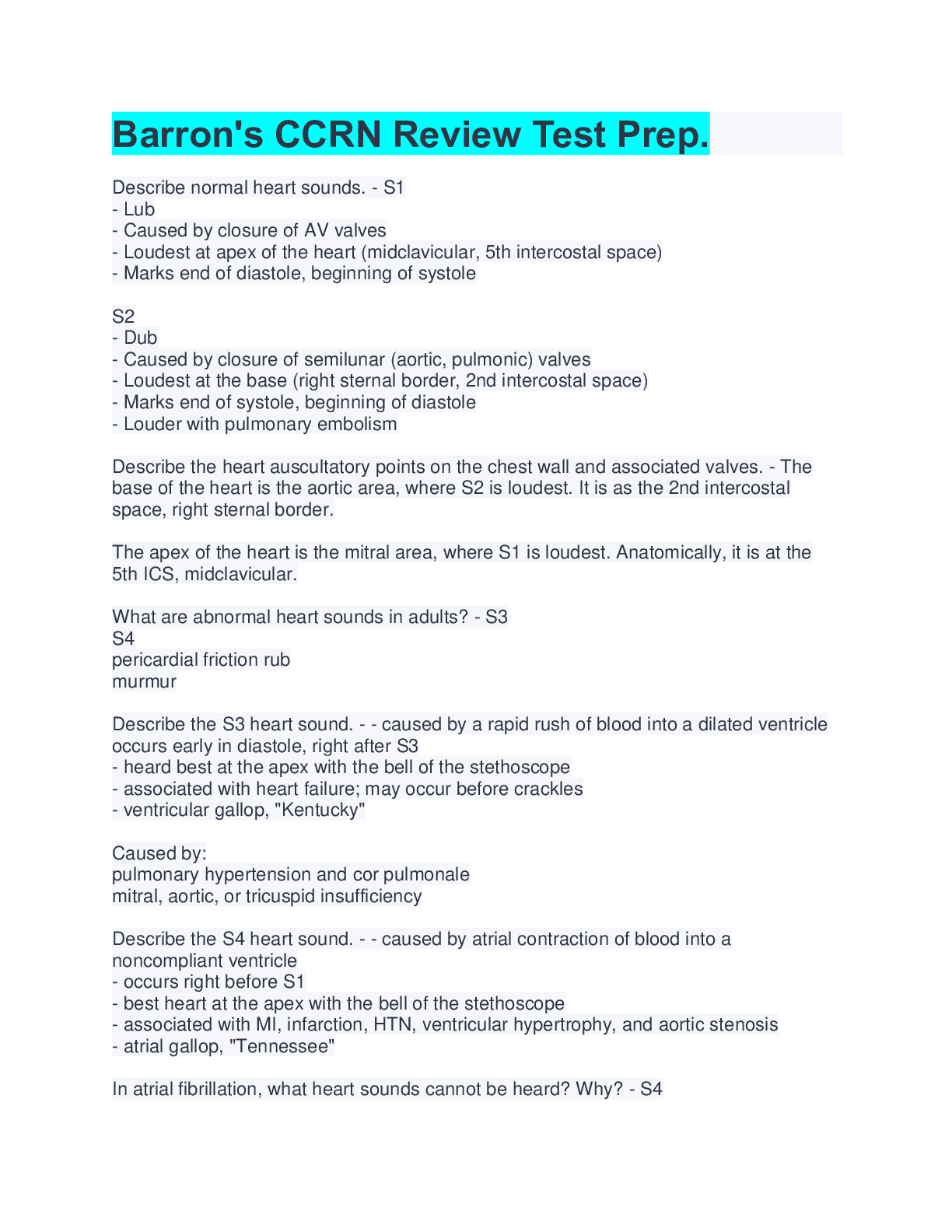
Reviews( 0 )
Recommended For You
Managerial Economics> Solutions Guide > Managerial Economics in a Global Economy 8th Edition By Dominick Salvatore (Solutions Manual ) (All)
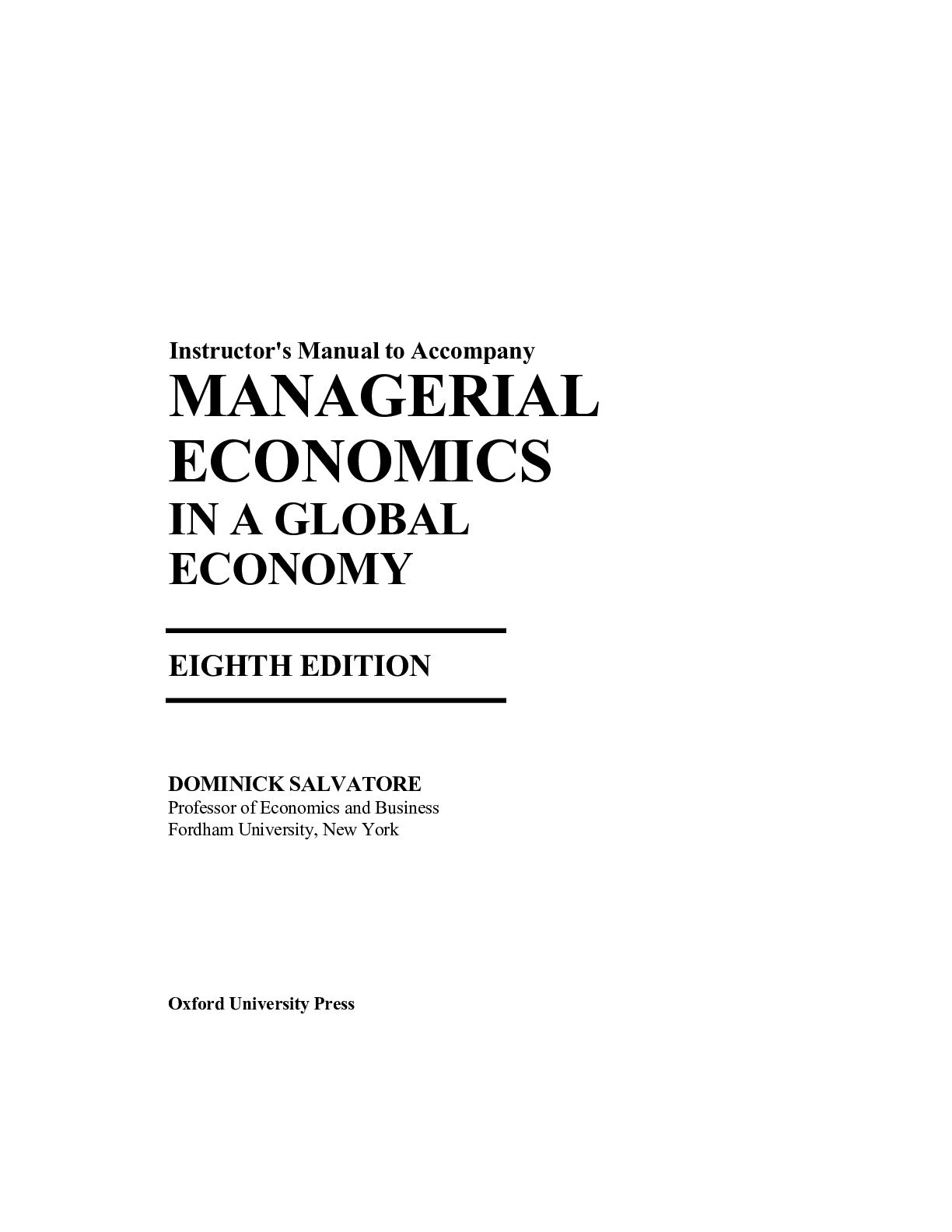
Managerial Economics in a Global Economy 8th Edition By Dominick Salvatore (Solutions Manual )
Reflecting the highly globalized nature of tastes, production, labor markets, and financial markets in today's world, Managerial Economics in a Global Economy, Eighth Edition, presents the theory of t...
By eBookSmTb , Uploaded: Jun 01, 2022
$20
Business Administration> Solutions Guide > Australasian Business Statistics 4th Edition By Black, Asafu ,Adjaye, Burke, Khan, King, Perera, Papadimos, Sherwood, Wasimi (Solution Manual All Chapters) (All)
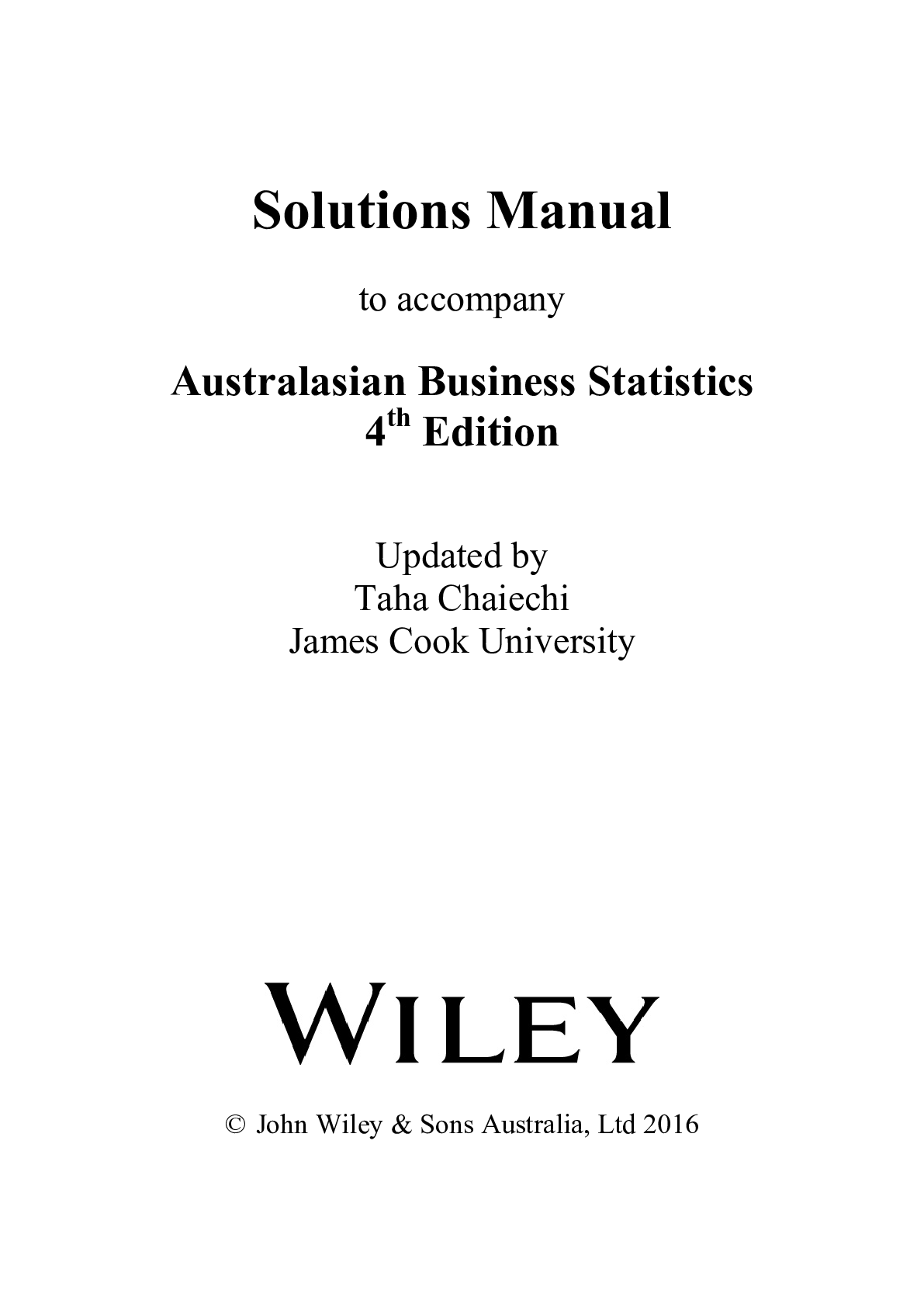
Australasian Business Statistics 4th Edition By Black, Asafu ,Adjaye, Burke, Khan, King, Perera, Papadimos, Sherwood, Wasimi (Solution Manual All Chapters)
Data-driven decisions are driving the global knowledge economy. To get the edge, graduates need the power of statistical analysis to create business insight. This fourth edition of Australasian Busine...
By eBookSmTb , Uploaded: Nov 23, 2021
$20
Business Law> Solutions Guide > International Economics Theory and Policy 12th edition By Paul R. Krugman, Maurice Obstfeld, Marc Melitz (Solutions Manual ) (All)

International Economics Theory and Policy 12th edition By Paul R. Krugman, Maurice Obstfeld, Marc Melitz (Solutions Manual )
1. Introduction PART 1: INTERNATIONAL TRADE THEORY 2. Word Trade: An Overview 3. Labor Productivity and Comparative Advantage: The Ricardian Model 4. Specific Factors and Income Distribution 5....
By eBookSmTb , Uploaded: Nov 05, 2022
$25
Education> Solutions Guide > Essentials of Accounting for Governmental and Not-for-Profit Organizations, 14th Edition By Paul Copley (Solutions Manual ) (All)
.png)
Essentials of Accounting for Governmental and Not-for-Profit Organizations, 14th Edition By Paul Copley (Solutions Manual )
The focus of Copley's Essentials of Accounting for Governmental and Not-for-Profit Organizations, 14th edition is on the preparation of external financial statements which is a challenge for governmen...
By eBookSmTb , Uploaded: Oct 07, 2022
$20
Urban Policy and Planning> Solutions Guide > Dental list Yellow pages (All)
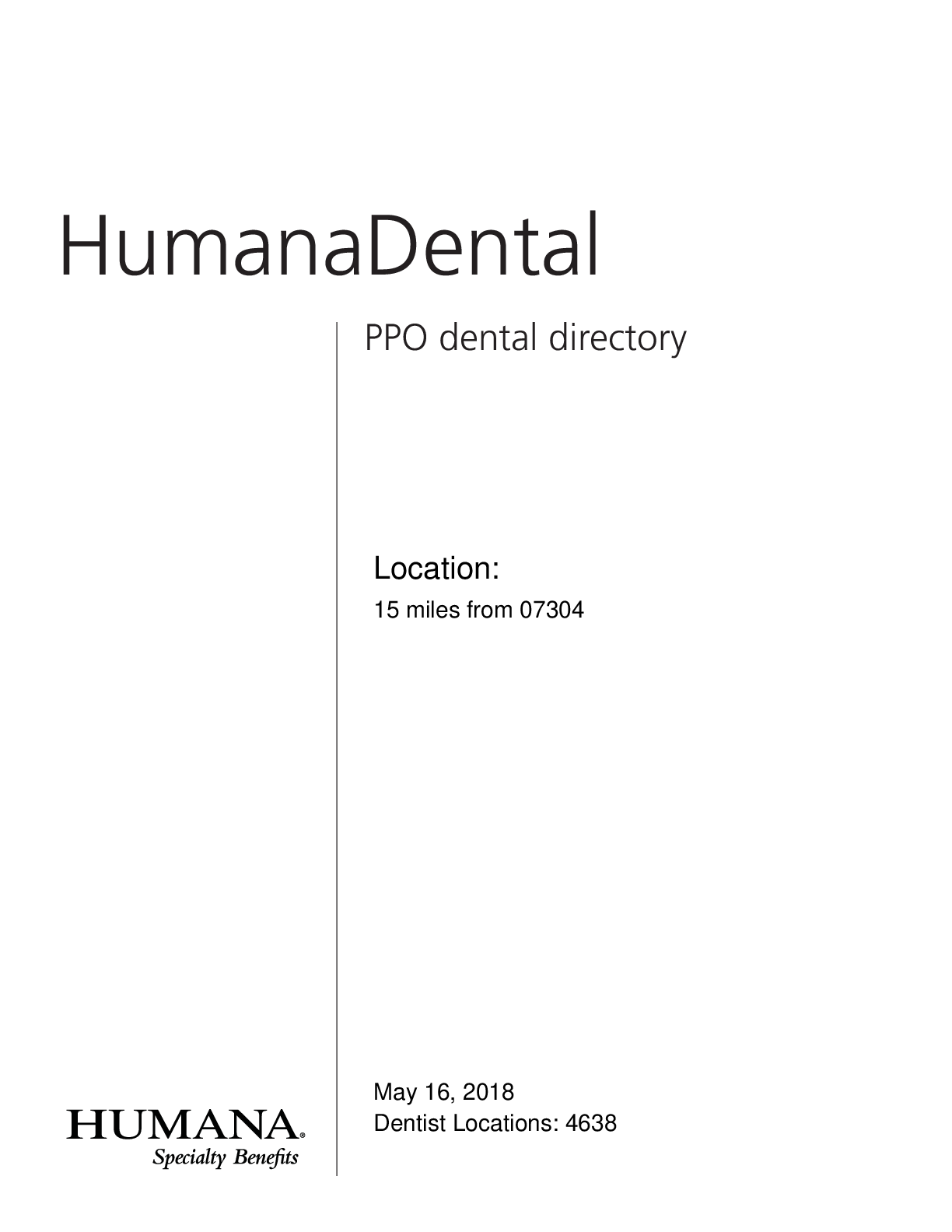
Dental list Yellow pages
HumanaDental PPO dental directory Location: 15 miles from 07304 May 16, 2018 Dentist Locations: 4638 Get the most out of your dental plan. the covered person must send us a letter requesting a...
By Academia1434 , Uploaded: Mar 30, 2021
$1
Statistics> Solutions Guide > MAT 240 Module Five Assignment Hypothesis Testing for Regional Real Estate Company (All)
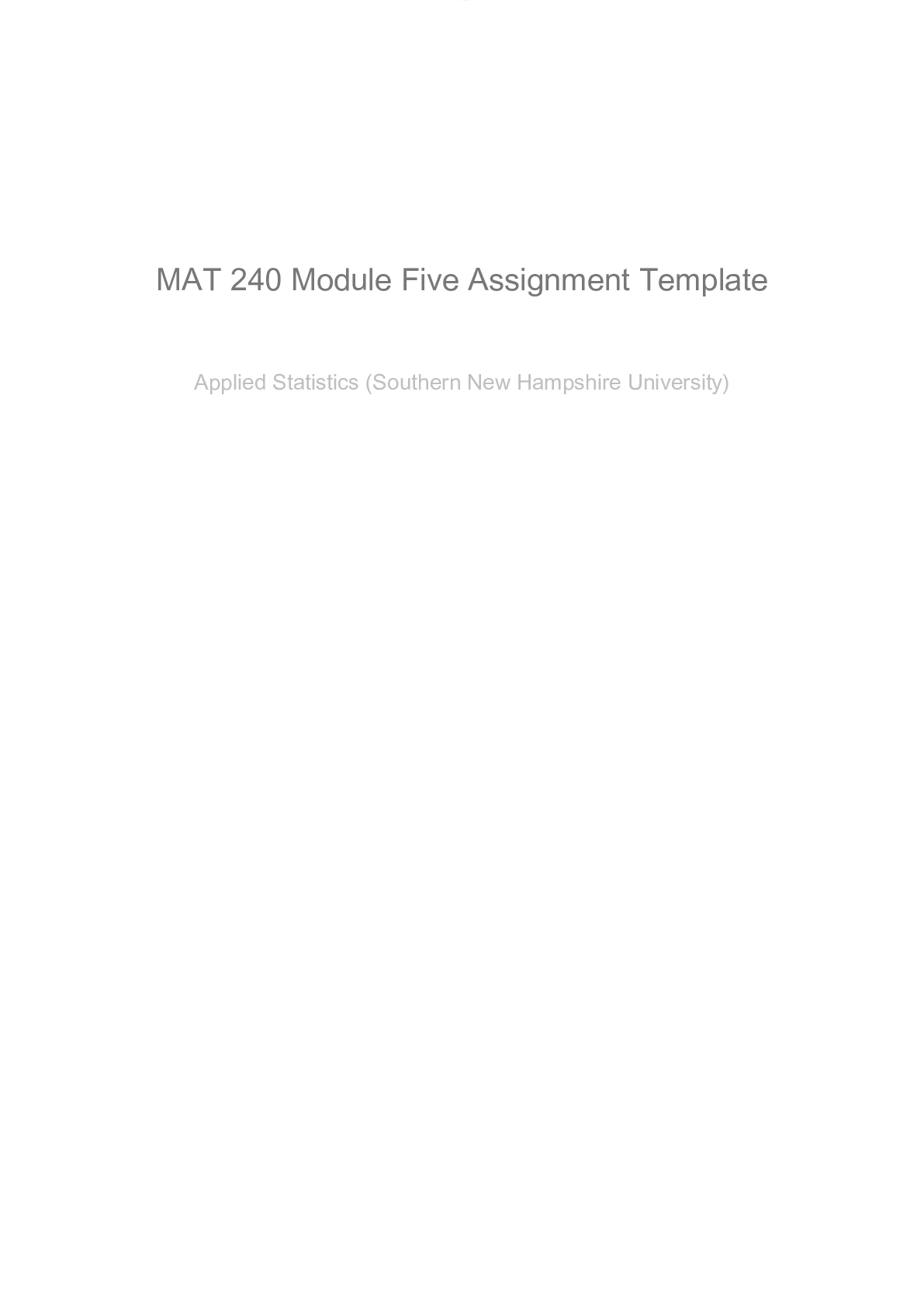
MAT 240 Module Five Assignment Hypothesis Testing for Regional Real Estate Company
Scenario You have been hired by the Regional Real Estate Company to help them analyze real estate data. One of the company’s Pacific region salespeople just returned to the office with a newly desi...
By ACADEMICTUTORIAL , Uploaded: May 26, 2022
$4
Finance> Solutions Guide > Week 4 Mini Case Complete The Chapter 9 (All)
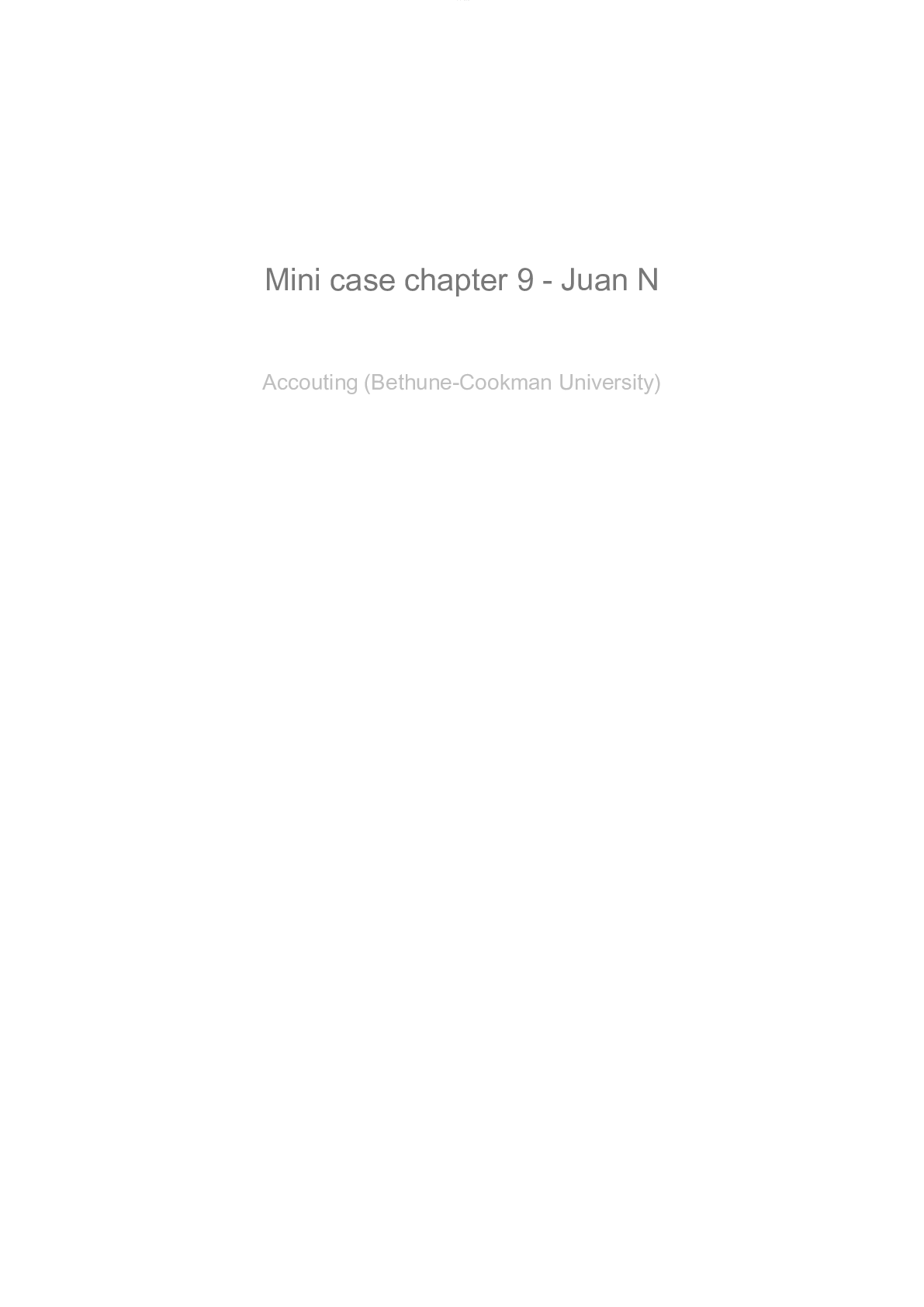
Week 4 Mini Case Complete The Chapter 9
During the last few years, Jana Industries has been too constrained by the high cost of capital to make many capital investments. Recently, though, capital costs have been declining, and the company h...
By ACADEMICTUTORIAL , Uploaded: May 26, 2022
$3.5
Accounting> Solutions Guide > ACCT370 Excel Project Part 3 (All)

ACCT370 Excel Project Part 3
EXCEL PROJECT: PROJECTING FINANCIAL STATEMENTS ASSIGNMENT INSTRUCTIONS OVERVIEW Common Sized Balance Sheets (Tabs 12), Common Sized Income Statements (Tab 13), Horizontal Analysis Balanc...
By ACADEMICTUTORIAL , Uploaded: Feb 14, 2023
$6.5
Business> Solutions Guide > Read the Chapter 19 Mini Case in Financial Management: Theory and Practice (All)
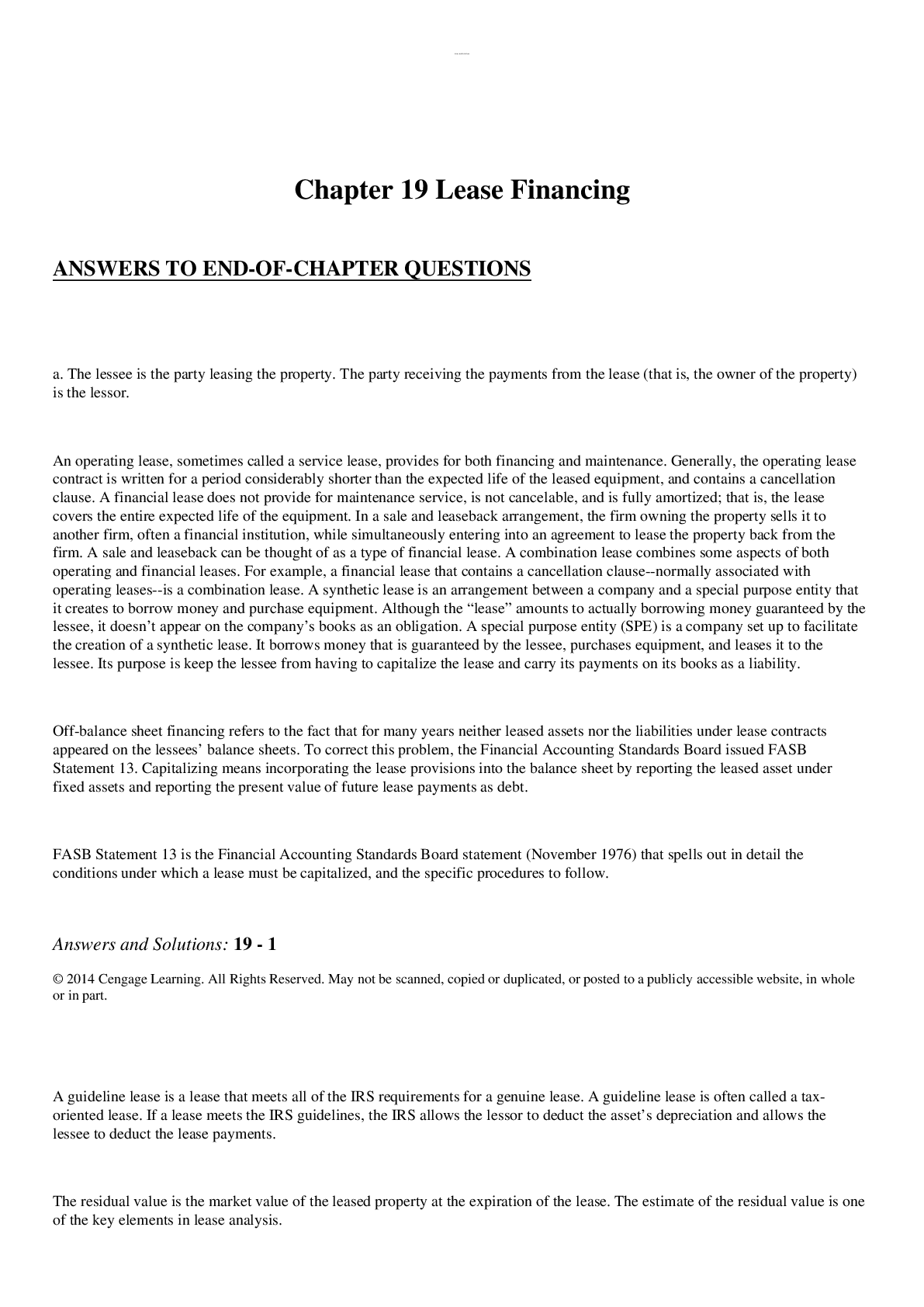
Read the Chapter 19 Mini Case in Financial Management: Theory and Practice
Chapter 18 leasing and financing Chapter 19 Mini Case in Financial Management Lewis Securities Inc Read the Chapter 19 Mini Case in Financial Management: Theory and Practice. Using complete sen...
By ACADEMICTUTORIAL , Uploaded: May 01, 2023
$5.5
Calculus> Solutions Guide > Applied Calculus, 6th Edition By Hughes-Hallett, Lock, Gleason (Solutions Manual) (All)
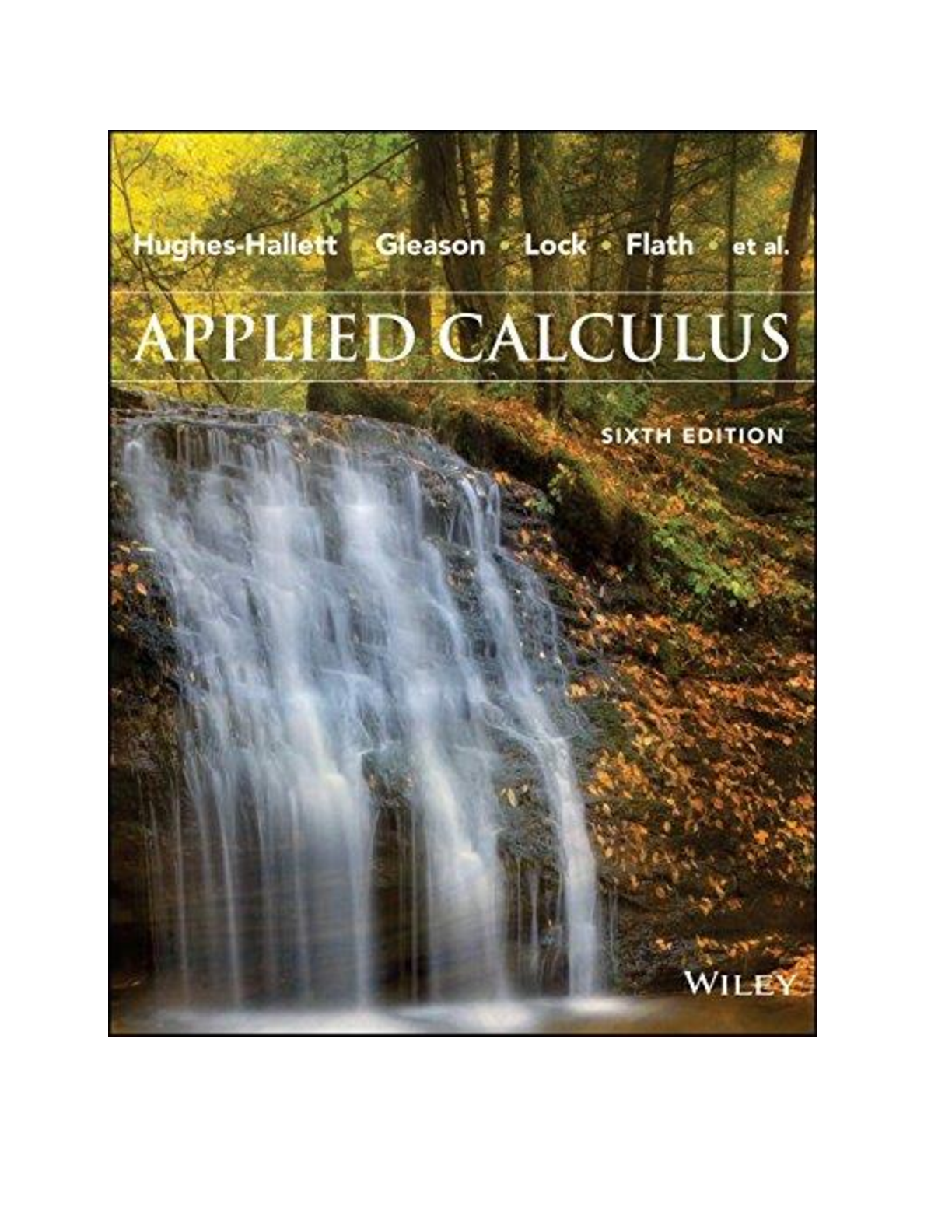
Applied Calculus, 6th Edition By Hughes-Hallett, Lock, Gleason (Solutions Manual)
A text for interactive Calculus courses, featuring innovative problems This sixth edition of Applied Calculus engages students with well-constructed problems and content to deepen understanding. The R...
By eBookSmTb , Uploaded: Dec 09, 2022
$25
Document information
Connected school, study & course
About the document
Uploaded On
Jul 30, 2022
Number of pages
72
Written in
Additional information
This document has been written for:
Uploaded
Jul 30, 2022
Downloads
0
Views
131






